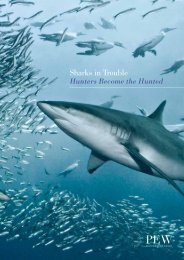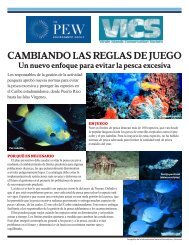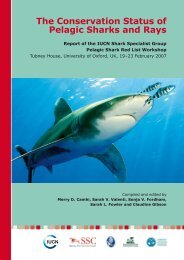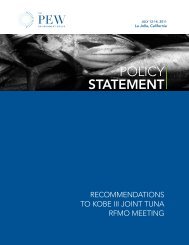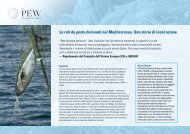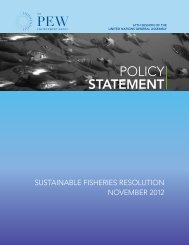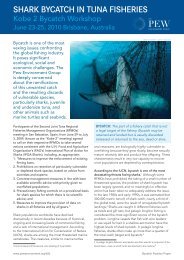The Marine Environment of the Pitcairn Islands - Pew Environment ...
The Marine Environment of the Pitcairn Islands - Pew Environment ...
The Marine Environment of the Pitcairn Islands - Pew Environment ...
You also want an ePaper? Increase the reach of your titles
YUMPU automatically turns print PDFs into web optimized ePapers that Google loves.
Table 18. Cetacean species recorded from <strong>the</strong> <strong>of</strong>fshore waters <strong>of</strong> <strong>the</strong> <strong>Pitcairn</strong> <strong>Islands</strong> EEZ. Species from: (A)<br />
Palomares et al., 2011, believed to be derived from species ranges/known migration routes ra<strong>the</strong>r than from<br />
actual sightings; and (B) Chris Gaskin <strong>of</strong> Pterodroma Pelagics (www.nzseabirds.com) on a bird-watching<br />
expedition to <strong>the</strong> <strong>Pitcairn</strong> <strong>Islands</strong> in June 2006. Status and notes from IUCN Red List (2012).<br />
Species IUCN Notes<br />
Code*<br />
Common or dwarf<br />
minke whale<br />
Balaenoptera acutorostrata<br />
Sei whale<br />
Balaenoptera borealis<br />
Blue whale<br />
Balaenoptera musculus<br />
Fin whale<br />
Balaenoptera physalus<br />
Humpback whale<br />
Megaptera novaeangliae<br />
Bryde’s whale<br />
Balaenoptera edeni<br />
Minke whale<br />
Balaenoptera acutorostrata<br />
(Short-nosed)<br />
common dolphin<br />
Delphinus delphis<br />
Pygmy killer whale<br />
Feresa attenuata<br />
Short-finned pilot whale<br />
Globicephala<br />
macrorhynchus<br />
Cuvier’s beaked whale<br />
Ziphius cavirostris<br />
Risso’s dolphin<br />
Grampus griseus<br />
Fraser’s dolphin<br />
Lagenodelphis hosei<br />
Killer whale<br />
Orcinus orca<br />
False killer whale<br />
Pseudorca crassidens<br />
Pantropical spotted dolphin<br />
Stenella attenuata<br />
Striped dolphin<br />
Stenella coeruleoalba<br />
Spinner dolphin<br />
Stenella longirostris<br />
Rough-too<strong>the</strong>d dolphin<br />
Steno bredanensis<br />
LC<br />
EN<br />
EN<br />
EN<br />
EN<br />
DD<br />
LC<br />
LC<br />
DD<br />
DD<br />
LC<br />
LC<br />
LC<br />
DD<br />
DD<br />
LC<br />
LC<br />
DD<br />
LC<br />
Occurs in both coastal and <strong>of</strong>fshore waters. High abundance <strong>of</strong> minke whales reported<br />
in November between 10° and 30°S in <strong>the</strong> central South Pacific. (A)<br />
Populations in <strong>the</strong> sou<strong>the</strong>rn hemisphere are listed as CITES Appendix I, indicating <strong>the</strong>y<br />
are threatened with extinction if hunting (for ‘scientific’ purposes) is not halted. (A)<br />
Occurs in <strong>the</strong> eastern Pacific from around 44°S in sou<strong>the</strong>rn Chile as far north as Costa<br />
Rica. Numbers severely depleted in <strong>the</strong> past by direct exploitation. However, <strong>the</strong>re<br />
appear to be no major threats to blue whales at present. (A)<br />
Occurs worldwide in <strong>of</strong>fshore waters, but typically confined to 50°–65°S in <strong>the</strong> South<br />
Pacific. Depleted worldwide by commercial whaling in <strong>the</strong> 20th century. Protected in <strong>the</strong><br />
Sou<strong>the</strong>rn Hemisphere since 1975. (A)<br />
Those within EEZ waters likely to belong to a sub-stock which includes <strong>the</strong> waters<br />
<strong>of</strong> Franch Polynesia (sub-stock F). Humpbacks have been protected from commercial<br />
whaling in <strong>the</strong> Sou<strong>the</strong>rn Hemisphere since 1963. (A)<br />
Within <strong>the</strong> past 20 years this species <strong>of</strong> baleen whale has been classified as a ‘complex’<br />
<strong>of</strong> a number <strong>of</strong> species, as <strong>the</strong>re has been confusion regarding its true identification by<br />
taxonomists. <strong>The</strong> ‘ordinary’ Bryde’s whale (<strong>the</strong> species given here) is known to have a<br />
distribution throughout <strong>the</strong> eastern tropical Pacific and across <strong>the</strong> South Pacific down to<br />
about 35°S. (B)<br />
This species is likely to be <strong>the</strong> ‘dwarf’ minke whale which taxonomists have only<br />
regarded as being separate from <strong>the</strong> Antarctic minke whale B. bonaerensis within <strong>the</strong><br />
past 15 years. Its distribution in <strong>the</strong> South Pacific is uncertain. (B)<br />
An oceanic species that is widely distributed in tropical to cool temperate waters <strong>of</strong> <strong>the</strong><br />
Atlantic and Pacific Oceans, from nearshore waters to thousands <strong>of</strong> kilometres <strong>of</strong>fshore.<br />
(A)<br />
A tropical/subtropical species that inhabits oceanic waters around <strong>the</strong> globe generally<br />
between 40°N and 35°S. Little is known about this species. (A)<br />
Found in warm temperate to tropical waters <strong>of</strong> <strong>the</strong> world, generally in deep <strong>of</strong>fshore<br />
areas. Feeds on vertically migrating prey. (A)<br />
Decaying carcass found on Edwards/Te Manu islet, Ducie in October 1991 by members<br />
<strong>of</strong> <strong>the</strong> Sir Peter Scott Commemorative Expedition. (A)<br />
A widely-distributed species, inhabiting primarily deep waters <strong>of</strong> <strong>the</strong> continental slope<br />
and outer shelf (especially with steep bottom topography), from <strong>the</strong> tropics through <strong>the</strong><br />
temperate regions in both hemispheres. It also occurs in some oceanic areas, beyond<br />
<strong>the</strong> continental slope, such as in <strong>the</strong> eastern tropical Pacific. (A)<br />
Exact distribution <strong>of</strong> this species is poorly known. Has a pantropical distribution, largely<br />
between 30°N and 30°S in all three major oceans. (A)<br />
<strong>The</strong> most cosmopolitan <strong>of</strong> all cetaceans and may be <strong>the</strong> second most widely ranging<br />
mammal species on <strong>the</strong> planet, after humans. (A)<br />
Found in tropical to warm temperate zones, generally in relatively deep, <strong>of</strong>fshore waters<br />
<strong>of</strong> all three major oceans. Feeds primarily on fish and cephalopods, but has also been<br />
known to attack small cetaceans, humpback whales, and sperm whales. (A)<br />
Presence in <strong>Pitcairn</strong> <strong>Islands</strong> EEZ waters uncertain. (A)<br />
A widely-distributed species, found in tropical and warm-temperate waters <strong>of</strong> <strong>the</strong><br />
Atlantic, Pacific and Indian Oceans. (A)<br />
<strong>The</strong> association <strong>of</strong> spinner dolphins with spotted dolphins and yellowfin tuna results in<br />
<strong>the</strong>ir entanglement in tuna purse seines in <strong>the</strong> eastern tropical Pacific. (A)<br />
A tropical to subtropical species which generally inhabits deep, oceanic waters <strong>of</strong> all<br />
three major oceans, rarely ranging north <strong>of</strong> 40°N or south <strong>of</strong> 35°S. In <strong>the</strong> eastern<br />
tropical Pacific it tends to associate with o<strong>the</strong>r cetaceans (especially pilot whales and<br />
Fraser’s dolphins). (A)<br />
* IUCN’s Red List categories (IUCN, 2012): EN = Endangered; LC = Least Concern; NE = Not Evaluated;<br />
DD = Data Deficient.<br />
waters <strong>of</strong>f California, 6,500 km to <strong>the</strong> north, could be<br />
reached if <strong>the</strong> birds flew for more than 12 hours a day,<br />
and Murphy’s petrels are seen most <strong>of</strong>ten in those waters<br />
during <strong>the</strong> incubation months <strong>of</strong> June and July.” (Brooke,<br />
2010).<br />
SEABIRDS<br />
<strong>The</strong> seabirds <strong>of</strong> particular conservation interest listed in<br />
Table 17 have been observed at sea within <strong>the</strong> EEZ, in<br />
addition to those species already listed for <strong>the</strong> nearshore<br />
waters <strong>of</strong> each island.<br />
CETACEANS<br />
Several species <strong>of</strong> whales and dolphins have been<br />
recorded from <strong>the</strong> <strong>of</strong>fshore waters within <strong>the</strong> <strong>Pitcairn</strong><br />
<strong>Islands</strong> EEZ. <strong>The</strong>se are listed in Table 18.<br />
TURTLES AND NON-COMMERCIAL FISH SPECIES<br />
See Table 19.<br />
40 <strong>The</strong> <strong>Marine</strong> <strong>Environment</strong> <strong>of</strong> <strong>the</strong> <strong>Pitcairn</strong> <strong>Islands</strong>: Offshore waters<br />
<strong>The</strong> <strong>Marine</strong> <strong>Environment</strong> <strong>of</strong> <strong>the</strong> <strong>Pitcairn</strong> <strong>Islands</strong>: Offshore waters<br />
4.4 Fisheries<br />
4.4.1 Non-commercial<br />
A New Zealand fishing expedition to 40-mile Reef (<strong>the</strong><br />
apex <strong>of</strong> <strong>the</strong> Adam’s Seamount, lying to <strong>the</strong> east-sou<strong>the</strong>ast<br />
<strong>of</strong> <strong>Pitcairn</strong>) took place in August 1994 (Sharples,<br />
1994). Using droplines, bottom longlines and handjigging<br />
methods, abundant catches <strong>of</strong> reticulate grouper<br />
Epinephelus tuamotuensis, coral trout Variola louti,<br />
blacktip grouper Epinephelus fasciatus and yellowtail<br />
kingfish Seriola lalandi were achieved fishing at depths <strong>of</strong><br />
70 to 185 m (Sharples, 1994).<br />
<strong>Pitcairn</strong> Islanders also visit 40-mile Reef, though<br />
infrequently (<strong>the</strong>ir last visit was in 2003/04). <strong>The</strong>ir catches<br />
have included various grouper species, coral trout Variola<br />
louti and trevally (probably Caranx ignobilis) (M. Christian,<br />
pers. comm.). Large numbers <strong>of</strong> sharks are known to<br />
frequent <strong>the</strong> reef and it also provides a feeding area for<br />
several species <strong>of</strong> seabird (G. Wragg, pers. comm.).<br />
Table 19. Oceanic turtle and non-commercial fish species recorded from within <strong>the</strong> <strong>Pitcairn</strong> <strong>Islands</strong> EEZ.<br />
Species from Palomares et al., 2011 believed to be derived from species ranges/known migration routes<br />
ra<strong>the</strong>r than from actual sightings.<br />
Species IUCN<br />
Code*<br />
Notes<br />
Hawksbill turtle<br />
Eretmochelys imbricata<br />
Green turtle<br />
Chelonia mydas<br />
Oceanic whitetip shark<br />
Carcharhinus longimanus<br />
Blue shark<br />
Prionace glauca<br />
Whale shark<br />
Rhincodon typus<br />
CR Has a circumglobal distribution throughout tropical and, to a lesser extent,<br />
subtropical waters including <strong>the</strong> Pacific Ocean. Hawksbills are migratory<br />
and individuals undertake complex movements through geographically<br />
disparate habitats during <strong>the</strong>ir lifetimes.<br />
EN Very little is known about <strong>the</strong>ir migratory movements in this part <strong>of</strong> <strong>the</strong><br />
world once <strong>the</strong>y return to <strong>the</strong> sea from a nesting beach. Has a circumglobal<br />
distribution, occurring throughout tropical and, to a lesser extent,<br />
subtropical waters. Highly migratory and undertakes complex migrations<br />
through geographically disparate habitats.<br />
VU This is one <strong>of</strong> <strong>the</strong> most widespread sharks, ranging across entire oceans in<br />
tropical and subtropical waters. It is caught in large numbers as a bycatch<br />
<strong>of</strong> pelagic fisheries. Listed as a highly migratory species under <strong>the</strong> 1995<br />
UN Agreement on <strong>the</strong> Conservation and Management <strong>of</strong> Straddling Fish<br />
Stocks and Highly Migratory Fish Stocks (UNFSA).<br />
NT One <strong>of</strong> <strong>the</strong> most wide-ranging <strong>of</strong> all sharks, being found throughout<br />
tropical and temperate seas from latitudes <strong>of</strong> about 60° N to 50°S. It is<br />
oceanic and pelagic, found from <strong>the</strong> surface to about 350 m depth. <strong>The</strong>y<br />
are a major bycatch <strong>of</strong> longline and driftnet fisheries.<br />
VU A cosmopolitan tropical and warm temperate species and <strong>the</strong> world’s<br />
largest living fish. Known to migrate over extremely large distances.<br />
Populations appear to have been depleted by harpoon fisheries in South-<br />
East Asia and perhaps incidental capture in o<strong>the</strong>r fisheries.<br />
* IUCN’s Red List categories (IUCN, 2012): CR = Critically Endangered; EN = Endangered; VU = Vulnerable;<br />
NT = Near Threatened;<br />
41




